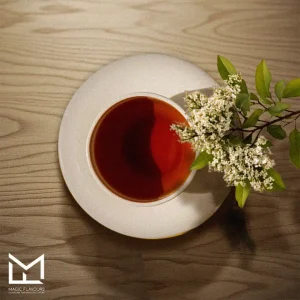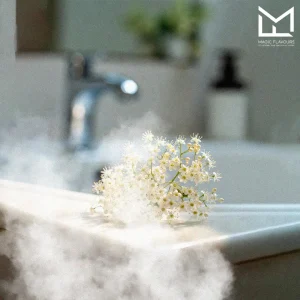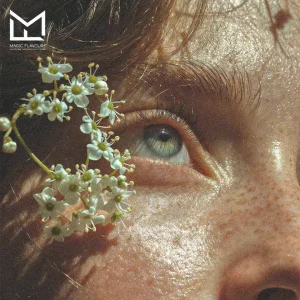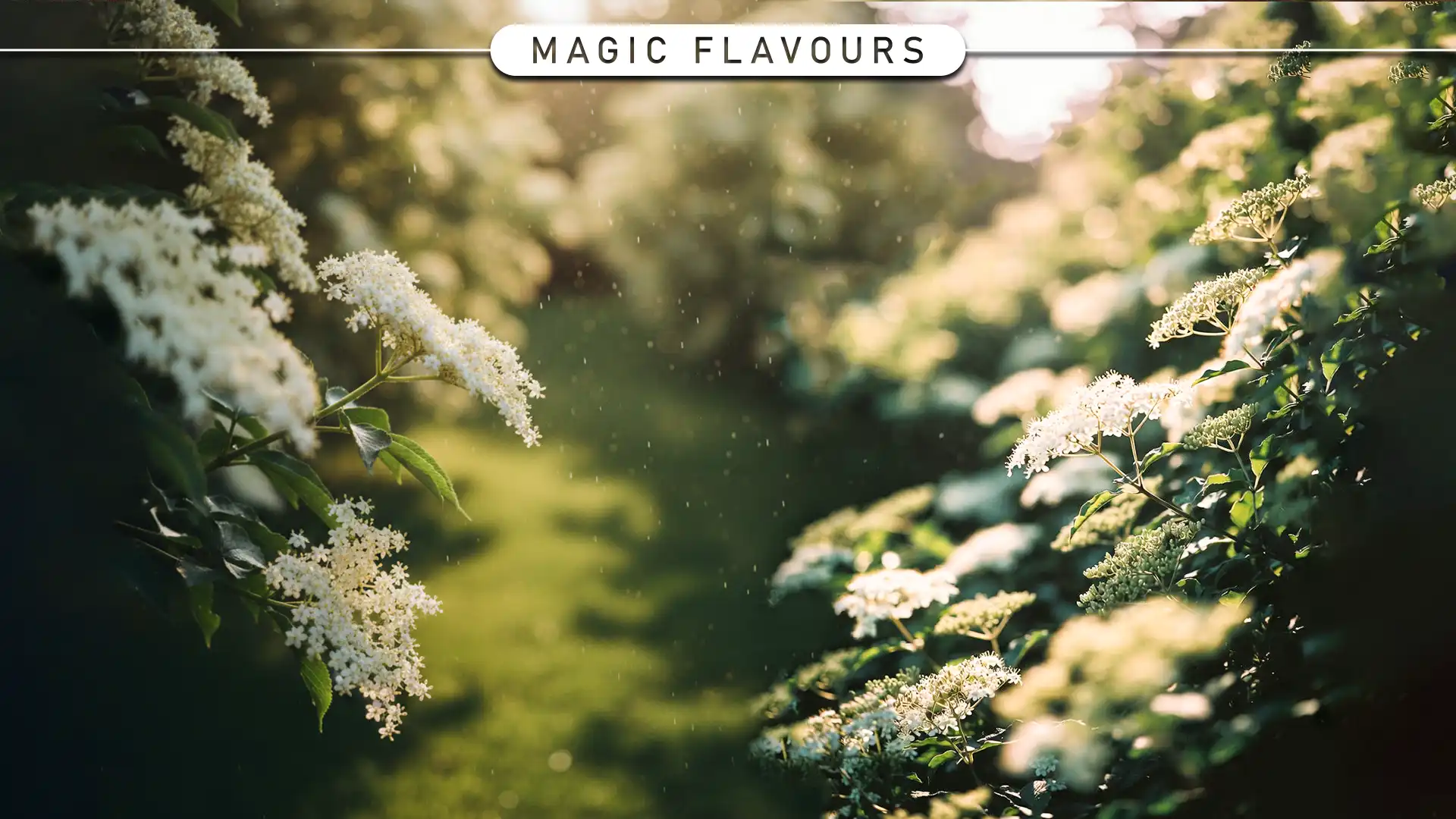1. Introduction to Elderflower Flavor
What Is Elderflower Flavor?
First, elderflower comes from the elder tree, known scientifically as Sambucus nigra. Then, people harvest its tiny white blossoms during late spring and early summer. Because the flowers are delicate, they must be picked carefully and used quickly.
Next, elderflower offers a light, floral scent with subtle sweetness. So, it often appears in syrups, teas, and desserts. Also, its blossoms are not the same as elderberries, which grow later in the season.
Finally, elderflower is prized for its gentle flavor and aromatic qualities. Because of this, chefs and herbalists use it in many creative ways. Its popularity continues to grow in both kitchens and wellness circles.
Historical Use of Elderflower Flavor in Food and Drink
First, ancient Europeans used elderflower in herbal remedies and seasonal drinks. Then, they infused it into wines and cordials for flavor and healing. Because of its pleasant aroma, it became a favorite in rural traditions.
Next, elderflower appeared in medieval recipes for tonics and syrups. So, people believed it could treat colds and fevers naturally. Also, it was often mixed with honey or lemon for added taste.
Finally, elderflower gained popularity in British and Scandinavian cuisine. Because of this, it became a key ingredient in summer beverages. Its legacy lives on in traditional recipes and modern cocktails.
Overview of Elderflower’s Flavor Profile
First, elderflower tastes light, floral, and slightly fruity. Then, it offers hints of pear, lychee, and honey. Because of its subtle sweetness, it pairs well with many ingredients.
Next, the flavor feels refreshing and delicate on the palate. So, it works best in cold drinks, desserts, and light sauces. Also, it adds elegance without overpowering other flavors.
Finally, elderflower’s aroma enhances its overall experience. Because of this, it’s often used in perfumes and teas. Its flavor profile makes it ideal for both culinary and aromatic uses.
2. Chemical Composition and Aroma Notes of Elderflower Flavor
Key Compounds Responsible for Flavor and Scent

First, elderflower contains flavonoids and phenolic acids. These compounds give it antioxidant properties and a light floral taste. Then, volatile oils like linalool and geraniol shape its sweet aroma.
Next, these oils evaporate quickly after harvest. So, fresh elderflower must be used or preserved fast. Also, the scent fades if exposed to heat or light.
Finally, the balance of compounds creates elderflower’s unique profile. Because of this, it feels both fruity and herbal. Its chemistry makes it ideal for infusions and perfumes.
What a Harvesting Affects Elderflower’s Taste
First, timing matters when picking elderflowers. Early morning harvests preserve more oils and flavor. Then, flowers should be dry and fully open.
Next, improper handling bruises the blossoms. So, this reduces aroma and introduces bitterness. Also, storing them too long weakens their taste.
Finally, gentle drying helps retain elderflower’s character. Because of this, air-drying in shade works best. Proper harvesting ensures a clean, fragrant result.
Fresh vs. Dried vs. Extracted Elderflower Flavor
First, fresh elderflower tastes light and floral. It works well in teas, syrups, and cocktails. Then, its aroma feels soft and slightly fruity.
Next, dried elderflower offers a deeper, earthy note. So, it suits herbal blends and baked goods. Also, drying concentrates its flavor and extends shelf life.
Finally, extracted elderflower feels more intense and sweeter. Because of this, it’s used in cordials and perfumes. Each form offers a different experience and purpose.
3. Culinary Applications of Elderflower Flavor
Elderflower Flavor in Sweet Recipes
First, elderflower adds elegance to cakes, tarts, and puddings. Then, bakers infuse syrups or extracts into sponge and cream layers. Because of its floral taste, it pairs well with vanilla and citrus.
Next, elderflower enhances fruit-based desserts. So, it complements berries, apples, and pears beautifully. Also, chefs drizzle elderflower syrup over sorbets and panna cotta.
Finally, elderflower works in jams and jellies. Because of this, it brings a light, fragrant twist to spreads. Its subtle sweetness makes every bite feel refreshing.
Elderflower Flavor in Beverages (Cordials, Syrups, Cocktails)

First, elderflower cordial is a classic summer drink. Then, people mix it with sparkling water or lemonade. Because of its light flavor, it refreshes without overpowering.
Next, elderflower syrup sweetens teas and mocktails. So, it adds floral depth to herbal blends and iced drinks. Also, bartenders use it in cocktails like Hugo or elderflower martinis.
Finally, elderflower pairs well with gin, vodka, and prosecco. Because of this, it appears in many festive drinks. Its aroma lifts spirits and adds sophistication.
Elderflower Flavor in Savory Dishes and Sauces
First, elderflower rarely appears in savory dishes. However, chefs use it to add floral notes to sauces. Then, it works well with creamy or citrus-based dressings.
Next, elderflower complements poultry and fish. So, it adds brightness to marinades and glazes. Also, it balances rich flavors with a light touch.
Finally, elderflower vinegar offers a tangy twist. Because of this, it enhances salads and roasted vegetables. Its subtle taste makes savory dishes feel more refined.
Regional Cuisines Featuring Elderflower Flavor
First, British cuisine celebrates elderflower in cordials and desserts. Then, Scandinavian countries use it in syrups and herbal drinks. Because of tradition, it appears in midsummer recipes.
Next, German kitchens include elderflower in jams and jellies. So, it often pairs with gooseberries or rhubarb. Also, Austrian chefs use it in fritters called “Hollerküchle.”
Finally, elderflower appears in Eastern European herbal remedies. Because of this, it blends culinary and medicinal roles. Its presence reflects deep cultural appreciation across regions.
4. Health Benefits and Traditional Uses of Elderflower Flavor
Elderflower Flavor in Herbal Remedies
First, elderflower has a long history in folk medicine. Then, healers used it to treat colds, flu, and sinus issues. Because of its soothing properties, it often appeared in warm teas.
Next, elderflower helped reduce fever and clear congestion. So, people drank it during seasonal illnesses. Also, it was combined with peppermint and yarrow for stronger effects.
Finally, elderflower was used in poultices and skin washes. Because of this, it helped calm rashes and minor wounds. Its gentle nature made it safe for children and elders.
Anti-inflammatory and Antioxidant Properties
First, elderflower contains flavonoids and vitamin C. Then, these compounds fight free radicals and reduce inflammation. Because of this, elderflower supports immune health and skin repair.
Next, studies show elderflower may ease joint pain. So, it’s used in natural remedies for arthritis and swelling. Also, its antioxidants protect cells from damage and aging.
Finally, elderflower helps detoxify the body. Because of this, it appears in cleansing teas and tonics. Its healing properties make it a favorite in herbal wellness.
Modern Wellness Trends

First, elderflower is gaining popularity in wellness products. Then, brands use it in teas, supplements, and skincare. Because of its gentle effects, it suits daily routines.
Next, elderflower appears in detox blends and immunity boosters. So, people drink it to feel refreshed and balanced. Also, it’s added to bath salts and facial sprays.
Finally, elderflower fits into holistic health lifestyles. Because of this, it’s embraced by herbalists and wellness seekers. Its blend of tradition and science keeps it in demand.
5. Pairing Elderflower Flavor with Other Flavors
Complementary Fruits, Herbs, and Spices
First, elderflower pairs well with citrus fruits like lemon and orange. Then, it blends smoothly with berries, especially strawberries and raspberries. Because of this, it often appears in summer desserts and drinks.
Next, elderflower matches herbs like mint and basil. So, it adds freshness to teas, syrups, and salads. Also, lavender and chamomile enhance its floral notes.
Finally, elderflower works with warm spices like cardamom and ginger. Because of this, it fits into baked goods and spiced cocktails. Its versatility makes it easy to mix and match.
Elderflower Flavor in Fusion Cuisine
First, modern chefs use elderflower in global dishes. Then, they blend it with Asian ingredients like lemongrass and lychee. Because of this, it adds elegance to fusion desserts and sauces.
Next, elderflower appears in Mediterranean recipes. So, it complements honey, figs, and soft cheeses. Also, it works in vinaigrettes and glazes for grilled meats.
Finally, elderflower enhances Latin-inspired drinks and sweets. Because of this, it pairs well with tropical fruits and chili. Fusion cuisine uses elderflower to surprise and delight.
Balancing Floral Sweetness in Recipes
First, elderflower has a soft, sweet flavor. Then, it needs balance to avoid tasting too perfumed. Because of this, chefs use acid or spice to tone it down.
Next, lemon juice or vinegar adds brightness. So, it sharpens the flavor and keeps it fresh. Also, salt or bitter notes help ground the sweetness.
Finally, use elderflower in small amounts. Because of this, it won’t overpower other ingredients. Balancing it well creates harmony in every dish.
6. Buying, Storing, and Preparing Elderflower
How to Choose and Harvest Elderflowers
First, look for elderflowers with creamy white petals and a strong scent. Then, avoid blossoms that appear brown, wilted, or damp. Because freshness fades fast, pick them early in the day.
Next, harvest only fully opened flower heads. So, use scissors to snip clusters gently from the tree. Also, shake them lightly to remove insects before storing.
Finally, choose flowers from clean, unsprayed areas. Because of this, you’ll avoid harmful chemicals and pollution. Clean harvesting ensures safe and flavorful results.
Storage Tips for Fresh and Dried Blossoms
First, use fresh elderflowers within 24 hours. Then, store them in a paper bag inside the fridge. Because plastic traps moisture, it can cause mold quickly.
Next, dry elderflowers for long-term use. So, spread them out in a cool, dark, and airy space. Also, turn them daily to prevent clumping and spoilage.
Finally, store dried blossoms in airtight containers. Because of this, they stay fragrant and usable for months. Label and date them to track freshness easily.
Preparation Techniques (Infusing, Cooking, Mixing)
First, rinse elderflowers gently to remove dust and insects. Then, trim away stems to avoid bitterness. Because only the blossoms carry flavor, discard green parts.
Next, infuse elderflower in hot water, syrup, or alcohol. So, steep for 10 to 15 minutes to extract aroma. Also, strain well to keep the texture smooth and clean.
Finally, mix elderflower into batters, creams, or drinks. Because of this, it adds subtle sweetness and floral depth. Use small amounts to avoid overpowering other flavors.
7. Elderflower Flavor in Non-Culinary Products
Elderflower in Skincare and Cosmetics
First, elderflower soothes and brightens the skin. Then, it reduces redness and calms irritation naturally. Because of this, it appears in toners, creams, and masks.
Next, elderflower offers antioxidant protection. So, it helps fight signs of aging and sun damage. Also, its gentle nature suits sensitive skin types.
Finally, elderflower extract hydrates and refreshes. Because of this, it’s used in eye gels and facial mists. Its floral scent adds a soft, clean touch to beauty products.
Elderflower Flavor in Fragrances and Aromatherapy
First, elderflower gives perfumes a light, sweet floral note. Then, it blends well with citrus, rose, and herbal scents. Because of this, it adds elegance and freshness to fragrance blends.
Next, elderflower oil promotes calm and clarity. So, people use it in aromatherapy to ease stress and tension. Also, it pairs well with lavender and chamomile in diffusers.
Finally, elderflower’s scent feels soft and uplifting. Because of this, it’s ideal for daily wellness rituals. Its aroma brings comfort and balance to the senses.
8. Cultural and Symbolic Significance
Elderflower Flavor in Folklore and Mythology
First, elderflower appears in many European myths and legends. Then, people believed it held protective and magical powers. Because of this, it was planted near homes and sacred places.
Next, Norse mythology linked elder trees to the goddess Freya. So, elderflower symbolized love, fertility, and feminine strength. Also, some stories warned against cutting elder trees without permission.
Finally, elderflower was used in rituals and charms. Because of this, it became a symbol of healing and transition. Its presence in folklore reflects deep respect for nature’s gifts.
Elderflower Flavor in Seasonal Celebrations and Traditions

First, elderflower blooms mark the arrival of summer. Then, people gather blossoms for cordials and festival treats. Because of this, it plays a role in midsummer traditions.
Next, British and Scandinavian cultures celebrate elderflower in seasonal recipes. So, it appears in drinks, fritters, and herbal remedies. Also, families pass down elderflower recipes through generations.
Finally, elderflower symbolizes renewal and light. Because of this, it’s used in solstice rituals and garden blessings. Its seasonal charm connects people to nature and heritage.
9. Conclusion
Recap of Elderflower’s Unique Flavor and Uses
First, elderflower offers a light, floral flavor with sweet and fruity notes. Then, it appears in desserts, drinks, sauces, and herbal remedies. Because of its versatility, it fits into both culinary and wellness routines.
Next, elderflower supports health with antioxidants and calming effects. So, it’s used in teas, tonics, and skincare products. Also, its scent enhances perfumes and aromatherapy blends.
Finally, elderflower carries cultural meaning and seasonal charm. Because of this, it plays a role in traditions and folklore. Its gentle nature makes it a beloved ingredient across the world.
Final Thoughts on Embracing Elderflower Flavor in Everyday Life
First, elderflower invites creativity in the kitchen and beyond. Then, try it in syrups, cocktails, or light desserts. Because of its soft flavor, it blends easily with fruits and herbs.
Next, explore elderflower in teas or wellness products. So, enjoy its calming scent and gentle healing properties. Also, use it to add elegance to your daily rituals.
Finally, elderflower connects flavor, health, and tradition. Because of this, it enriches both body and spirit. Embrace its beauty and let it brighten your everyday life.
